Addiction
Addiction: A Systems Perspective
Addiction creates and amplifies imbalance; recovery counteracts it.
Posted April 21, 2015

Addiction is a disorder of the brain’s reward pathway mediated by dopamine and other neurotransmitters. The American Society of Addiction Medicine (ASAM) defines addiction as a primary chronic disease of the brain’s circuitry related to reward, motivation, and memory, rather than simply a problem based in behavior. Addiction drives a need to use substances in pursuit of neurochemical reward and/or relief.
Active addiction is a relentless deviation-amplifying system—a system that over time throws itself further and further out of balance. Take the weathering of rock, for example. It begins with a tiny crack. A small amount of water collects in the crack. The water freezes and the force of the ice it forms enlarges the crack in the rock, however slightly. The larger crack collects more water, which makes the crack still larger when it freezes. The process continues—the growing crack collects greater amounts of water that freezes, increasing the size of the crack until it breaks the rock altogether, shattering it into pieces.
Neuroscience demonstrates that repetitive experiences involving substances—or activities, such as gambling, eating, sexual involvement, video gaming, spending, etc.—have profound effects on the brain’s chemistry and anatomy, effectively taking over the reward pathway and contorting priorities to enable their continuation. Over time, the capacity for conscious choice dissipates, and with enough repetitions effectively disappears. Addiction in all its forms includes the diminution of voluntary control and a deviation-amplifying cycle of repetitious and self-defeating behavior.
The human brain adapts to repetitive experiences by forming memory connections or tracks. These connections are created by changes in brain structure and functioning, and work in the brain’s operating system—outside of conscious awareness. When repeated consistently over time, any activity, behavior, or experience—whether healthy and positive or unhealthy and destructive—can create new unconscious memory tracks.
These memory tracks are what eventually allow activities to be performed without conscious thought or effort. This process is not unlike the grading and paving of a roadway that allows traffic to travel easily and efficiently. In the brain, over time the repetition of an activity can effectively turn a dirt road into a freeway. In this way, habits—those patterns of behavior that develop through repetition—are the cause, as well as the result of these kinds of changes in the brain.
The repetitive experiences and behaviors people engage in over the course of active addiction create new neural pathways and lead to certain changes in the brain, including the formation of very specific memory tracks. For example, the experience of pain—physical or emotional (though they generally bleed into and exacerbate one another)—usually and rapidly translates into an impulse to “fix,” numb, or escape. These memory tracks become manifest in the literal habits of addiction—the patterns, routines, and rituals related to thinking, feeling, and acting that fuel the use of mind- and mood-altering substances or activities to feel “good” or feel “better.”
Fortunately, neuroplasticity gives the brain the ability to change and adapt throughout a person’s life. Through the processes of thinking, learning, and acting, the brain continuously lays down new pathways for the processing and communicating of information and reorganizes existing ones, as connections between neurons are generated, rewired, and refined. Over time, our brains become neuroanatomical refections of our priorities and values.
It is the brain’s capacity to make these changes that gives us the ability to memorize new facts, form new memories, adjust to new experiences and environments, integrate new learning, and develop new skills. Repetitive experiences also serve to deepen learning and strengthen mental, emotional, and muscle memory.
Recovery functions as a deviation-counteracting system that helps people re-establish intrapersonal and interpersonal equilibrium. When subjected to imbalancing influences, deviation-counteracting systems course-correct. In recovery, this takes the form of utilizing conscious awareness to recognize when our thoughts, emotional reactions, physical status, and/or sense of connection with others and with the world, are out of balance—and using particular skills to bring the system back into mental, emotional, physical, and spiritual balance.
Such deviation-counteracting skills include cognitive restructuring (CBT), cognitive diffusion (ACT), distress tolerance and emotional regulation (DBT), and applying the spiritual principles of honesty, accountability, responsibility, compassion, forgiveness, service, and gratitude. Meditation and other mindfulness enhancing practices that promote attention with intention and awareness of one’s present experience—whether those experiences are pleasurable, painful, or neutral—with acceptance are inherently deviation-counteracting. It is important to note that the learning and practicing of all these skills (albeit often using different language) is part and parcel of the twelve-step approach to recovery, at least as it’s practiced in certain of the twelve-step programs. Although these approaches may seem disparate, when brought together they can complement one another to create a therapeutic whole much greater than the sum of its parts.
The brain’s resilience and exquisite ability to adapt to new and different repetitive experiences is what gives even older dogs the capacity to learn and master new tricks. In recovery, the brain has the opportunity to heal and rebuild the connections that were damaged and distorted during active addiction. Research using brain scans indicates that with about one year of abstinence, noticeable healing of the adverse changes caused by active addiction has taken place,[i] and with five years of abstinence, the brain often begins to resemble that of a person who has never used alcohol or other drugs. Every day we have the opportunity to create memory tracks that support recovery. By engaging in recovery-oriented practices one day at a time, these memory tracks can form the foundation of the “habits” of recovery. And, maintaining the habits of recovery is the most effective form of relapse prevention.
Copyright 2015 Dan Mager, MSW
Author of Some Assembly Required: A Balanced Approach to Recovery from Addiction and Chronic Pain
[i] N. D. Volkow et al, “Loss of Dopamine Transporters in Methamphetamine Abusers Recovers with Protracted Abstinence,” Journal of Neuroscience 21 (2001): 9414–9418.




